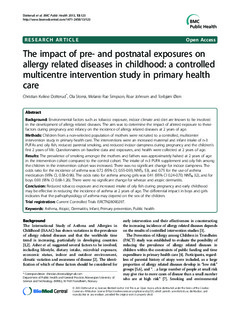| dc.contributor.author | Dotterud, Christian Kvikne | |
| dc.contributor.author | Storrø, Ola | |
| dc.contributor.author | Simpson, Melanie Rae | |
| dc.contributor.author | Johnsen, Roar | |
| dc.contributor.author | Øien, Torbjørn | |
| dc.date.accessioned | 2015-09-11T12:37:00Z | |
| dc.date.accessioned | 2015-09-29T13:26:31Z | |
| dc.date.available | 2015-09-11T12:37:00Z | |
| dc.date.available | 2015-09-29T13:26:31Z | |
| dc.date.issued | 2013 | |
| dc.identifier.citation | BMC Public Health 2013, 13 | nb_NO |
| dc.identifier.issn | 1471-2458 | |
| dc.identifier.uri | http://hdl.handle.net/11250/413392 | |
| dc.description.abstract | Background: Environmental factors such as tobacco exposure, indoor climate and diet are known to be involved
in the development of allergy related diseases. The aim was to determine the impact of altered exposure to these
factors during pregnancy and infancy on the incidence of allergy related diseases at 2 years of age.
Methods: Children from a non-selected population of mothers were recruited to a controlled, multicenter
intervention study in primary health care. The interventions were an increased maternal and infant intake of n-3
PUFAs and oily fish, reduced parental smoking, and reduced indoor dampness during pregnancy and the children’s
first 2 years of life. Questionnaires on baseline data and exposures, and health were collected at 2 years of age.
Results: The prevalence of smoking amongst the mothers and fathers was approximately halved at 2 years of age
in the intervention cohort compared to the control cohort. The intake of n-3 PUFA supplement and oily fish among
the children in the intervention cohort was increased. There was no significant change for indoor dampness. The
odds ratio for the incidence of asthma was 0.72 (95% CI, 0.55-0.93; NNTb 53), and 0.75 for the use of asthma
medication (95% CI, 0.58-0.96). The odds ratio for asthma among girls was 0.41 (95% CI 0.24-0.70; NNTb 32), and for
boys 0.93 (95% CI 0.68-1.26). There were no significant change for wheeze and atopic dermatitis.
Conclusion: Reduced tobacco exposure and increased intake of oily fish during pregnancy and early childhood
may be effective in reducing the incidence of asthma at 2 years of age. The differential impact in boys and girls
indicates that the pathophysiology of asthma may depend on the sex of the children. | nb_NO |
| dc.language.iso | eng | nb_NO |
| dc.publisher | BioMed Central | nb_NO |
| dc.title | The impact of pre- and postnatal exposures on allergy related diseases in childhood: a controlled multicentre intervention study in primary health care | nb_NO |
| dc.type | Journal article | nb_NO |
| dc.type | Peer reviewed | en_GB |
| dc.date.updated | 2015-09-11T12:37:00Z | |
| dc.source.volume | 13 | nb_NO |
| dc.source.journal | BMC Public Health | nb_NO |
| dc.identifier.doi | 10.1186/1471-2458-13-123 | |
| dc.identifier.cristin | 1027388 | |
| dc.description.localcode | © 2013 Dotterud et al.; licensee BioMed Central Ltd. This is an Open Access article distributed under the terms of the Creative Commons Attribution License (http://creativecommons.org/licenses/by/2.0), which permits unrestricted use, distribution, and reproduction in any medium, provided the original work is properly cited. | nb_NO |
